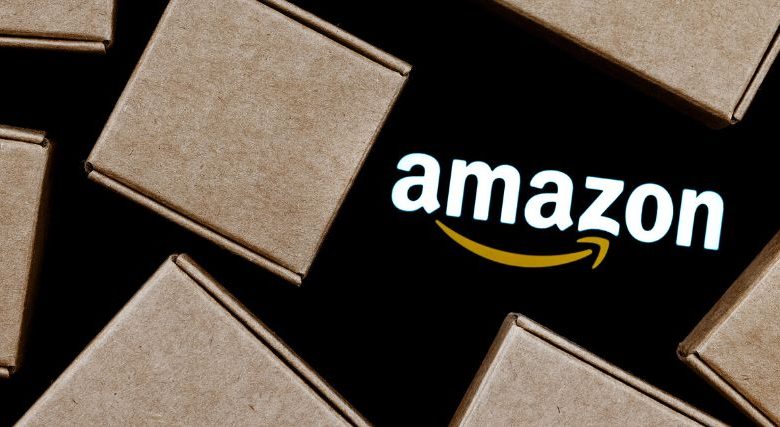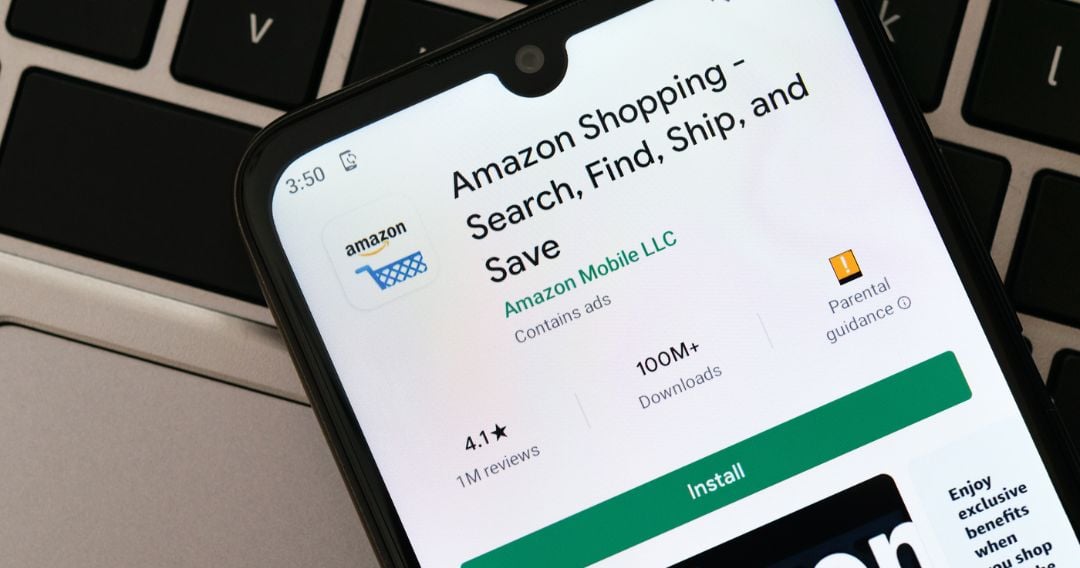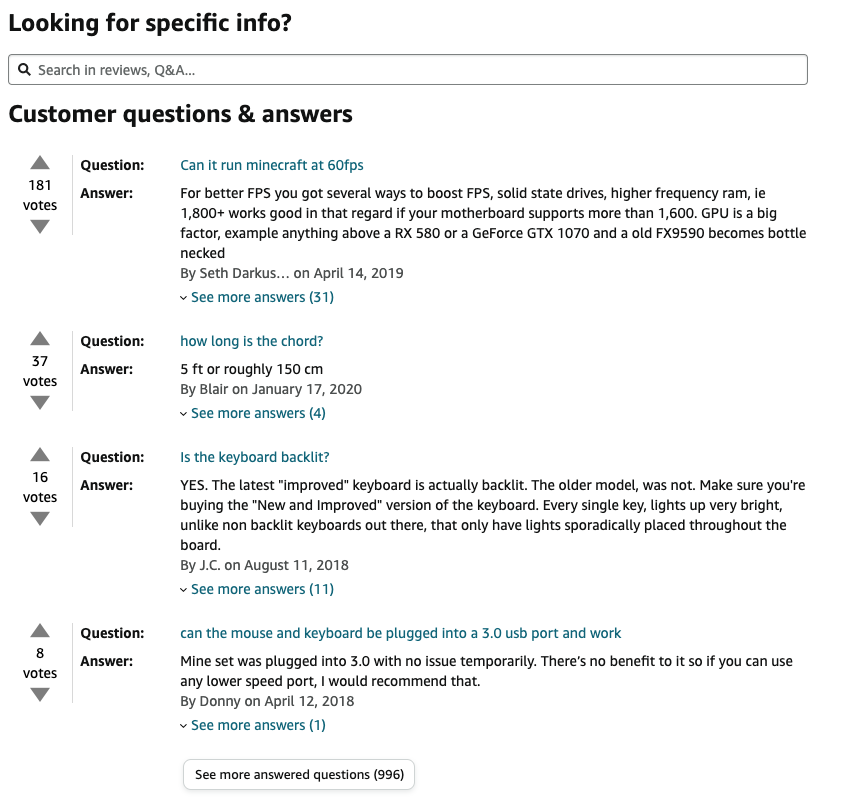Amazon Marketing Strategy 2024: Trends, Tips & Examples

Creating an effective Amazon marketing strategy could be one of the most powerful things you do for your e-commerce brand. After all, even if you have your own website for selling products, listing items on Amazon can significantly improve your brand reach and your revenue.
Today, 63% of online shoppers use Amazon to begin their search for products. Many even prefer to visit Amazon before they leverage the Google search platform. Amazon’s phenomenal market presence and its connection with its target audience can help retailers from all corners of the world increase their profits and find new customers.
However, with countless companies already advertising and showcasing their products on Amazon, it’s important to ensure you have the right strategy in place to stand out from the crowd. Today, we’re going to be exploring how you can update and enhance your Amazon marketing strategy based on the trends and e-commerce purchasing patterns of 2024.
What is Amazon Marketing?
Let’s start with the basics: what is Amazon marketing?
Amazon Marketing is the art and science of ensuring your products and services stand out to consumers on the Amazon platform. It’s how you leverage a combination of SEO (Search Engine Optimization), paid advertising campaigns, and external omnichannel promotion to boost your presence on Amazon and earn more sales.
Amazon is one of the world’s biggest e-commerce marketplaces. It holds an inventory of more than 12 million items across various categories and consumes around 45% of the American e-commerce market. In other words, if your customers are shopping online, there’s a good chance they’re using Amazon to find products and brands.
Amazon marketing is how you ensure your products are noticed by the right customers on the Amazon platform at a time when the marketplace is expected to surpass Walmart as the world’s largest retailer. With Amazon marketing, you boost your presence in the marketplace, increasing your chances of conversions. After all, 70% of Amazon customers never click past the first page in the search results when searching for a product.
As demand for e-commerce continues to increase, interest in Amazon marketing is expanding. Currently, 34% of advertisers say they’re planning on increasing their Amazon ad spending in the years ahead.
Why You Need an Amazon Marketing Strategy in 2024
Simply put, an Amazon Marketing strategy ensures you can stand out on the primary platform customers are using to find e-commerce products. Amazon currently accounts for nearly 40% of e-commerce sales, making it an incredibly valuable tool for any online brand.
Unfortunately, the open nature of the platform means there’s a lot of competition to deal with. An Amazon marketing strategy is how you ensure your company stands out from the crowd through display ads, SEO, and carefully cultivated and targeted campaigns.
An Amazon marketing strategy ensures you can get your products not just in front of buyers but in front of the customers most likely to purchase your product. It helps you to boost brand awareness and credibility by connecting your organization with one of the world’s best-known e-commerce platforms. Plus, it can help you to deliver a faster, more trustworthy shopping experience.
Thanks to Amazon Insights, building a marketing strategy for the platform is also an excellent way to gain a better knowledge of your customers’ habits, behaviors, and expectations. The data you gather from your campaigns will assist you in developing new products, planning campaigns, and effectively implementing strategies for growth.
The Evolution of Amazon Marketing in 2024

The important thing companies need to remember when developing their Amazon marketing strategy is the platform is constantly changing. Just like other major search engines and brands, Amazon frequently works to develop better experiences for both its partners and customers.
At the end of 2022, Amazon announced the introduction of a range of new advertising features designed to not only make it more competitive in the e-commerce space but also transform the way consumers and companies connect in 2024 and beyond.
Some of the most recent updates you should be aware of when building your strategy include:
- Sponsored display updates: In 2022, Amazon announced the arrival of a new feature allowing companies to add Amazon shopping credits directly into their Sponsored display creative, boosting their chances of converting more customers. Amazon also introduced a sponsored display option for brands that don’t sell directly in the Amazon store.
- New ad channels: As marketing preferences continue to change, Amazon has begun to take a more omnichannel approach to its advertising strategies. Companies can now leverage convenient video creation tools, which allow them to showcase their products through immersive content. There are also digital signage ads now available for stores.
- Preset campaign settings: Making it easier for every company to get started with Amazon Advertising, Amazon introduced presets for campaign settings, which support organizations in improving their ad settings. Amazon found campaigns launched with presets achieved 77% higher clicks, 29% higher conversions, and more engagement.
- Performance recommendations: Amazon has long offered companies insights into their ad campaigns to help them optimize and improve their listings. The new in-console Performance recommendations enhance the Ad console to assist organizations in optimizing their campaigns. They can include recommendations on keywords and bid suggestions.
- Amazon Marketing Cloud enhancements: The Amazon Marketing Cloud has recently been updated with digital subscription events, sponsored display options, and the ability to manage DSP audiences within the cloud.
Amazon Marketing Trends to Embed into Your Strategy in 2024
Based on the recent changes to the Amazon Ads environment, and the transforming expectations of customers in the e-commerce world, many organizations will need to upgrade their marketing strategy. To succeed in today’s competitive landscape, companies will need to become more versatile with their ad campaigns, more customer-driven, and more open to using data.
Here are some of the key trends you should be implementing into your Amazon marketing strategy heading into 2024 and beyond.
1. Experimenting with Video Content
Amazon provides companies with a multitude of ways to showcase their products and increase brand awareness through images, SEO-optimized listings, and carefully cultivated profiles.
As we head into 2024 and beyond, the recent changes to the Amazon platform indicate video will become more valuable to businesses of all sizes. In fact, 88% of people say they’ve been convinced to purchase something from a brand after watching a video.
The new video creation tools within the Amazon Ads environment will make it easier for businesses from any background to start designing how-to videos, product demonstrations, and visual ads for their campaigns. Customers are increasingly expecting to see more valuable content from the businesses they buy from, even on Amazon.
Case Study
We can already see examples of how video content is paying off for brands on the Amazon platform. For instance, Warner Bros partnered with IMDb entertainment advertising and Amazon ads to create video campaigns that would drive consumers from IMDb towards the Amazon listing pages for the new movie “The Batman.”
The cross-channel marketing campaign allowed Warner Bros to increase awareness of its new offering and drive more attention to the products available on Amazon. The strategy resulted in a click-through rate that was higher than any metric for movies like Dune or King Richard. Warner Bros’ success in increasing awareness and generating higher click-through rates for their new offerings serves as an example of the advantages of collaborating with skilled professionals who can craft and distribute compelling video content across multiple platforms.
How to Take Advantage of the Trend
The first step in making sure you can leverage video content effectively in your Amazon marketing strategy is learning how you can use video on Amazon. You’ll need to be a part of the Amazon Brand Registry to create video ads, and you need to be an active Amazon seller.
You’ll also need to follow the recommendations provided by Amazon, which include making sure videos are 1920 x 1080px, don’t include any complex slang, and don’t make any price-saving claims. Amazon also requires videos to be short (no longer than 15 seconds).
Once you know how to use Amazon video ads correctly, define your campaigns based on what you know about your audience. Ask yourself what kind of content they’ll consider to be most valuable, such as insights into your product or information about your latest release. You can even create videos for your product listings like Viante does here: https://a.co/d/12qQ5aM

Amazon offers a wide range of display advertising options on its platform, created to promote brand growth, awareness, and conversions. The Amazon Brand Registry allows companies to leverage this paid advertising technique to target and retarget customers both on Amazon and outside of the platform, using product-focused ads.
Sponsored display ads are particularly popular on Amazon because they’re highly targeted. Rather than using just keywords to target customers, these tools allow you to pinpoint customers based on their specific purchasing preferences. As of 2023, companies can even boost their chances of conversions by leveraging shopping credits and rewards within the display ad content.
In 2021, Amazon found 92% of customers were more likely to take action if they were offered an Amazon shopping credit in an ad. Demonstrating the value of your purchase to your customers with extra rewards could be an excellent way to increase conversions.
Case Study
For years, companies have been leveraging the display ad solutions in Amazon to boost brand awareness and unlock additional sales. For instance, Bagail, the travel and home accessories company, focused its efforts on sponsored display campaigns using a vCPM model.
This strategy for bid optimization, combined with the unique voucher feature within the Sponsored Display ad environment, allowed the company to showcase its latest offers to specific customers with designated preferences. When using the technology, Bagail found the discoverability of their products and brand name doubled. Additionally, sales attributed to display ads increased by 100%
How to Take Advantage of the Trend
Leveraging Amazon Display ads in your marketing campaigns is relatively straightforward, but your success will depend heavily on your targeting strategy. You can choose between a range of audience options, including “product targeting” strategies, and audience targeting strategies, which focus on either remarketing campaigns or audience interests.
Choose your targeting options carefully, and make sure you experiment with your bid and daily budget to determine which strategies will drive the most return on investment. It’s also worth previewing your campaign before you publish anything to check for any issues.
Remember to add all of your products to the campaign, and ensure you have enough budget assigned to keep your ad live throughout the day. Track your campaigns regularly to see whether they’re missing out on critical conversions and impressions, and experiment with different voucher, offer, and credit options to increase sales.
Remember, your brand should shine through in your display ads, showcasing the unique values you’re offering your customers. Look at this example from Arlo, for instance:

3. Invest in Omnichannel Marketing
While Amazon may be the number one e-commerce channel for customers today, it’s not the only platform consumers use to learn about brands and businesses. Similarly, customers are looking for a wider range of different styles of content to help them learn about products, from videos and images to blog posts and social media content.
Creating an omnichannel marketing campaign is how you ensure you can get your product and company in front of consumers wherever they are. With Amazon’s recent updates, you can leverage videos on multiple platforms to drive customers back to Amazon. You can also take advantage of digital signage campaigns if you’re part of the Amazon Fresh community.
A good omnichannel strategy involves using multiple different campaign types on Amazon, as well as external marketing strategies, to consistently increase the volume of traffic coming to your store. As consumers continue to expand their purchasing journeys throughout 2024, this will be essential.
Case Study
In 2021, the Nanit parenting brand worked with LSM Global to improve its brand presence across Amazon and throughout the online world. The company wanted to improve page hits, sales, and new customers with a range of different strategies, so they created an omnichannel campaign.
During this strategy, LSM Global used the Amazon DSP platform for media buys to increase Nanit’s awareness among potential customers.
They leveraged insights from advertiser-sourced audiences and took advantage of Amazon’s research and analytics to create more targeted campaigns. The omnichannel strategy increased Nanit’s views by 131% year-over-year, as well as its revenue by 84%.
How to Take Advantage of the Trend
Developing an effective omnichannel approach for your Amazon marketing strategy requires careful consideration of both your customers and your marketing mix. Start by collecting as much information as you can about your target audience, so you can effectively determine where your consumers spend the majority of their time online.
Find out what kind of campaigns your competitors are using, and ask yourself whether it might be beneficial to expand your reach across new channels and media, such as social media, video, email marketing, and even content creation. Explore different styles of ads, from sponsored campaigns to videos, to boost your chances of reaching the right audience.
Remember to send your customers back to your Amazon page as often as you can, using your other promotional channels. For instance, @DotsForSpots even includes a mention of Amazon in their Instagram profile, as well as links to listings within their bio link.
4. Use Data to Improve Targeting

Amazon is constantly updating its advertising tools and strategies to help companies create more personalized experiences for their target audience. The more data you use to drive your campaigns, the more likely you are to collect visitors from the right customer groups.
As the competition on Amazon continues to grow in the years ahead, companies will need to be even more stringent with their targeting strategies. Fortunately, Amazon gives you a number of options to leverage data in your campaigns. You can set up manual or automatic targeting and use your automated targeting strategies to test critical terms for your SEO campaigns too.
With updates to the Performance Recommendations solution in Amazon to access in 2023, companies will be able to access actionable best-practice guidance for their sponsored product campaigns directly. So, there’s no excuse to avoid taking full advantage of data.
Case Study
In early 2022, Logitech wanted to connect with adult consumers across Brazil, purchasing products for students returning to school. To achieve the right results, they used careful location and demographic-based targeting, along with behavioral insights, to build their Amazon DSP campaign.
With this strategy, Logitech worked with the data they could access within the Amazon environment to reach audiences with a specific interest in technology, gaming, and electronics. The Logitech and Amazon Ads campaign saw a 1% click-through rate and earned 23.6 million impressions.
Using the Amazon Marketing Cloud, the company even learned that combining an event page with an always-on advertising strategy helped to increase purchase rates by 20 times!
How to Take Advantage of the Trend
In any marketing strategy, data can be an extremely valuable tool. Collecting insights about your audience is the best way to ensure you’re positioning your marketing campaigns in front of the right people. The right strategy will often involve combining your internal data with the information and insights you can leverage from Amazon.
Once you’ve collected as much information as you can about your target audience and their preferences, use it to guide your advertising decisions. Amazon will allow you to manually or automatically create audiences based on the knowledge you have. Additionally, gaining expertise through an Amazon AWS Certification can enhance your understanding of leveraging the data you have gathered effectively.
You’ll also be able to adjust your bid for different placements in Sponsored Brands and Sponsored Products sections to help you focus on reaching your goals. Remember, your audience is likely to consistently evolve and change over time, so use the metrics you collect from each campaign on Amazon to determine what your next strategy should be.
5. Leverage User Generated Content
User-generated content, such as reviews and ratings, has always been a crucial part of standing out on the Amazon marketplace. However, these tools have grown increasingly important in recent years as consumers lose trust in the brands operating online. Today, around 80% of people use social media for buyer advice, and many will refuse to purchase a product without reviews.
Adding user-generated content to your Amazon Marketing campaign could be one of the best ways to boost the credibility and trust of your brand, as well as separate you from your competition. Plus, since Amazon allows customers to filter through products based on their ratings and reviews, you might find you get more attention on the organic search pages too.
Leveraging user-generated content can also make your product listings more appealing by showcasing star ratings alongside your sponsored ads on the platform.
Case Study
From the beginning of its partnership with Amazon, the Little Rainy company quickly began leveraging sponsored ads across the Amazon network to boost its chances of success. However, the company quickly found that it needed to earn the trust of its customers to continue increasing transactions. As such, they created their own “confidence” index.
The confidence index checklist involved everything from making sure the company had a strong presence related to specific search terms and using user-generated content and ratings effectively. By the end of its ad optimization process, Little Rainy increased its conversion rate by 1.17% and boosted its average daily orders by three times.
How to Take Advantage of the Trend
Amazon gives retailers a number of ways to showcase UGC and social proof on their listings, from star ratings to question-and-answer sections. The biggest challenge facing most brands is actually collecting reviews and testimonials from customers.
Fortunately, there are various ways you can boost your chances of receiving feedback. Amazon has its own dedicated “Request a review” tool within the Seller Central system, which allows you to automatically ask customers to review your products after making a purchase. There’s also the “Early Reviewer” program, which motivates shoppers to leave reviews in exchange for Amazon credit.
You can also consider signing up for Amazon Vine, which invites some of the most trusted reviewers on Amazon to try out new and soon-to-be-released products on the platform. Taking advantage of all these strategies is a great way to boost engagement. It’s also helpful to actively respond to customers in the question and answers section of your listing like Redragon does here:

6. Improve Your Amazon SEO
Similar to user-generated content, SEO is another crucial tool you should always use when building your Amazon marketing strategy. If you want your products to stand out among a range of options from other companies, you need to make sure you’re using the right keywords in your product descriptions, titles, and even your paid ads.
There’s more to leveraging this strategy than simply including as many crucial terms in your Amazon listing content as possible. You also need to ensure you’re balancing your use of crucial terms with content that customers actually want to read. Amazon calls this “A+ content.”
Remember, you can also expand your SEO potential on Amazon with the creation of additional solutions, like “Posts,” which allow you to showcase products in a visual format, with tags connected to the terms you want to rank for.
Case Study
Organic breakfast and snack food company Nature’s Path took advantage of a variety of SEO strategies in their campaigns with Amazon. The organization leveraged search term reports within Amazon Insights, as well as category targeting, to ensure they could boost their chances of reaching the right customers in their marketplace.
Using a carefully optimized strategy alongside visual content to engage and convert customers, Nature’s Path was able to increase its click-through rate by two times and achieve a 1.5 times increase in ROAS while reducing cost-per-click by 50%.
How to Take Advantage of the Trend
The first step in developing a strong SEO strategy for your Amazon marketing strategy is to research your target audience. Learn as much as you can about your customer personas and the kinds of terms and phrases they would use to search for you online. You can use the Amazon search term reports in your Seller profile to give you more insights.
Once you have your keywords, make sure you’re embedding them into the right environments. Optimize your product title, focusing on the terms customers are looking for and the benefits your product has to offer. Add terms to your product descriptions, and enhance your product key features “bullet point” section. Make sure you’re adding tags to your Amazon images and videos too.
Use A+ content to describe product features in unique ways to increase traffic, and leverage the “Manage your Experiments tool” on Amazon to run A/B tests. This will help you to define exactly which kinds of content are driving the most conversions on your store.
For a good example, look at how Razer optimizes its product listing for the term “gaming mouse”:


7. Constantly Measure and Optimize your Ads
Finally, the importance of monitoring, measuring, and optimizing your marketing strategies is nothing new to most companies on Amazon. However, as browsers begin to block third-party cookies, many advertisers are struggling to effectively measure conversions.
As the industry continues to change, it’s becoming much harder to measure attribution and campaign performance across multiple channels. Fortunately, Amazon is taking steps to reduce attribution problems within the Amazon Marketing Cloud.
The comprehensive toolkits offered by Amazon, including the Amazon Publisher Direct and DSP platforms and the Sizmek ad suite, all provide tools for ad addressability and ad measurement. It will be crucial for companies to take advantage of these tools in the years ahead.
Case Study
Apparel brand Orolay focuses on building affordable garments with premium-quality materials. However, the company has had a hard time properly monitoring and optimizing its ad campaigns in recent years. Working with Amazon Ads, the company looked for new ways to learn more about the customer journey and how they could promote the right content.
Using the Amazon Marketing Cloud, Orolay was able to learn more about the stages of consideration customers went through before making a purchase. They also worked with a marketing agency to apply proprietary modeling strategies to campaigns to improve media attribution and budget allocation. The result was better sales across Amazon and improved multi-channel presence.
The company achieved a 300% improvement in their deal of the day conversions compared to the year before. What’s more, their purchase rate increased by 13.5%.
How to Take Advantage of the Trend
The best way to ensure you can effectively monitor the results of your Amazon campaigns, and optimize your advertising presence, is to take advantage of the tools Amazon has to offer. The Amazon Marketing Cloud, for instance, is a cloud-based, privacy-safe solution where advertisers can leverage analytics using a variety of different tools.
The platform allows you to inspect campaign reach, frequency, and total impact across the marketing funnel. Plus, the media mix analysis allows you to better understand a media channel’s incremental value on your marketing campaigns.
Using audience insights and journey assessment tools, you can determine exactly what kind of ads you should be producing, in which environments, as well as how much of your budget you should be attributing to different marketing campaigns. You can even create custom attribution strategies for monitoring the success of your omnichannel campaigns.
Updating your Amazon Marketing Strategy for 2024
Amazon remains one of the most important channels for any e-commerce company in 2024. Regardless of what you choose to sell online, Amazon can help you to get your products in front of your target audience, improve your credibility, and increase your revenue.
However, as the marketplace continues to change and competition continues to grow, it’s important to ensure you’re constantly updating your Amazon marketing strategy. The tips above should help you to build a campaign that’s more suited to the Amazon customers of 2024 and beyond.
However, if you need some extra help with making Amazon’s ad systems work for you, it’s always worth talking to a professional. Reach out to Toptal today to be matched with an Amazon marketing expert who can help you to reach your goals.



